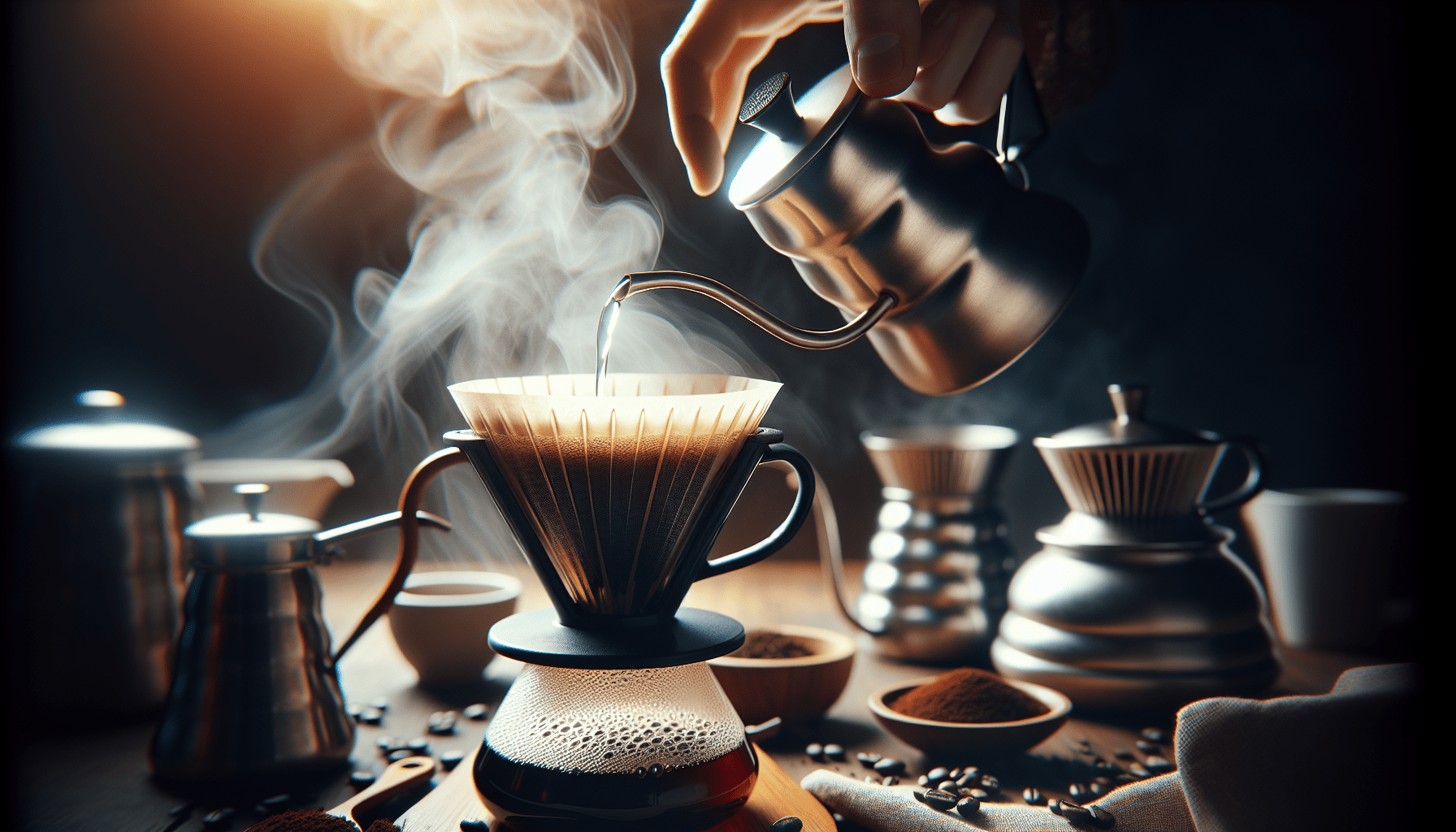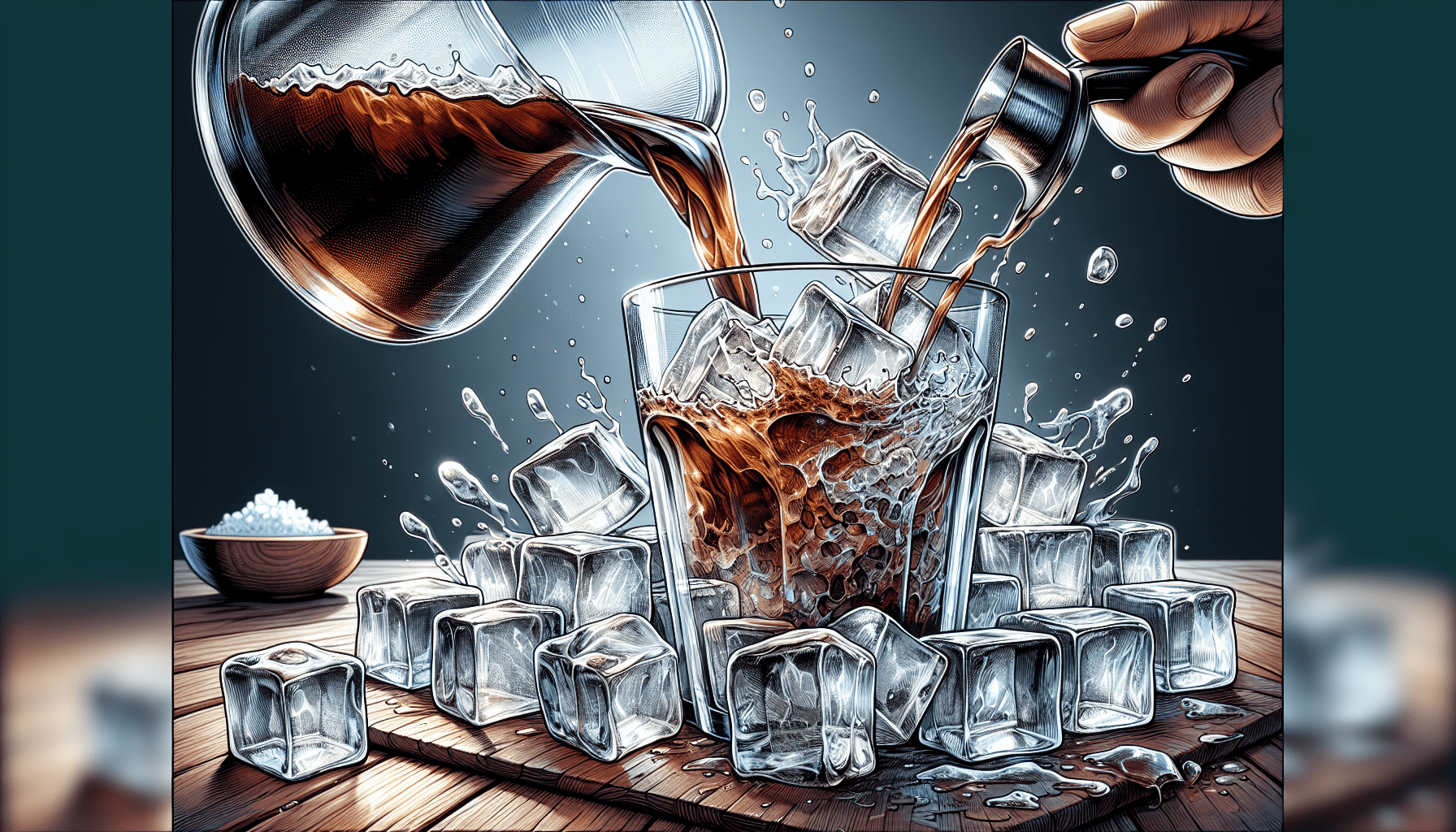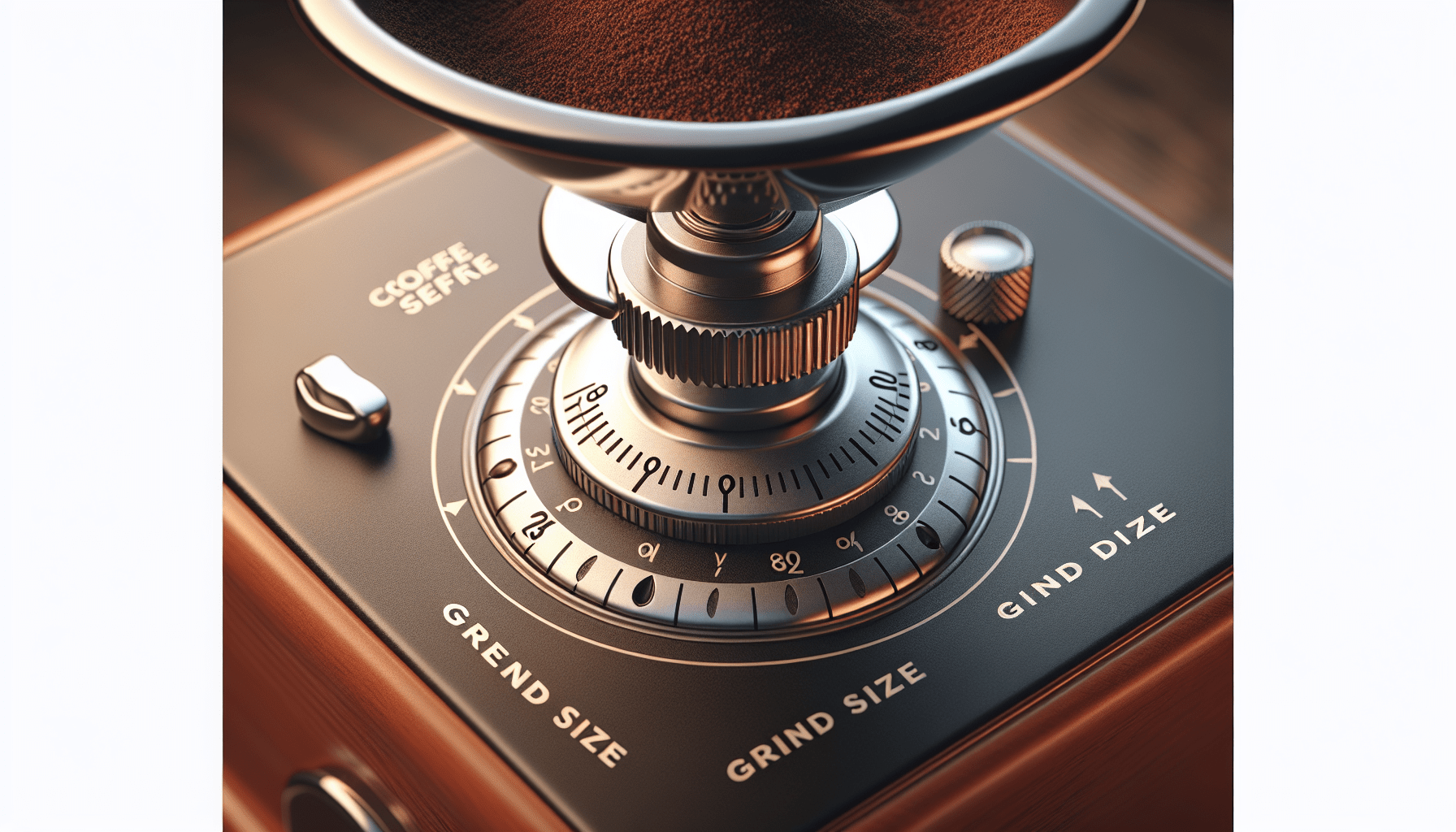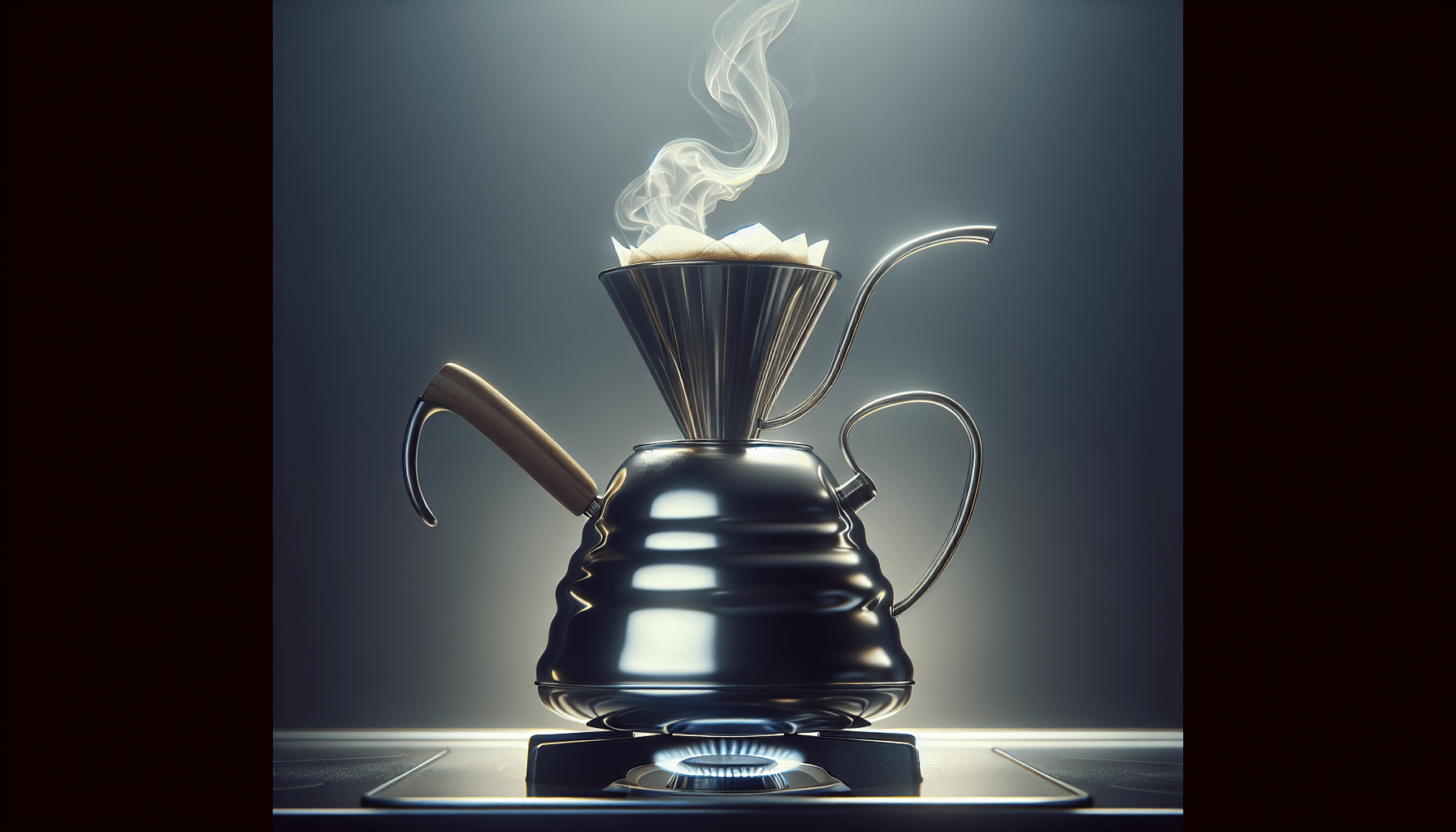Once you grasp the art of making pour-over coffee, you’ll soon find yourself indulging in a rich and aromatic brew that surpasses any other method. But amidst the excitement of preparing your own delicious cup, you may find yourself pondering a critical question: how do you know when the coffee is fully brewed? Fear not, my friend, for within this article lies the answer to this puzzling conundrum. We shall unlock the secret to detecting the perfect moment when your pour-over coffee is artfully prepared, leaving you with a delightful cup that satisfies both your senses and your caffeine cravings. So, grab your favorite mug, and let us embark on this journey of coffee exploration together, shall we?
Understanding the Pour-over Coffee Making Process
What is a pour-over coffee maker?
A pour-over coffee maker is a simple brewing device that allows you to manually brew coffee by pouring hot water over coffee grounds. It consists of a conical-shaped funnel, often made from ceramic or glass, that sits on top of a mug or a carafe. The coffee maker relies on gravity to extract the flavors and aromas from the grounds, resulting in a clean and flavorful cup of coffee.
How does a pour-over coffee maker work?
The pour-over coffee making process involves three main steps: pre-wetting the filter, blooming the coffee, and evenly pouring hot water over the grounds. Firstly, you pre-wet the filter to remove any paper taste and to heat up the brewing vessel. Then, you add coffee grounds to the filter and pour a small amount of hot water over them, allowing the coffee to bloom and release gases. Finally, you gradually pour hot water in a circular motion, ensuring that all the coffee grounds are saturated and allowing the water to pass through the filter, extracting the flavors and aromas.
Why choose pour-over coffee making?
Pour-over coffee making offers several advantages that make it a popular choice among coffee enthusiasts. Firstly, it allows for greater control over the brewing process, allowing you to adjust various variables such as water temperature, pour rate, and agitation, resulting in a customized cup of coffee. Additionally, pour-over brewing produces a cleaner and crisper taste profile compared to other brewing methods. The manual nature of pour-over brewing also allows you to appreciate and engage with the coffee-making process, making it a satisfying and enjoyable ritual.
Importance of Timing in Brewing Coffee
Why is timing important in pour-over brewing?
Timing plays a crucial role in pour-over brewing as it directly affects the extraction of flavors and the overall quality of your coffee. Brewing for too short a time can result in under-extracted coffee, which tastes weak and lacks complexity. On the other hand, brewing for too long can lead to over-extraction, resulting in a bitter and unpleasant flavor. Therefore, understanding and controlling the brewing time is essential to achieving the desired balance of flavors in your cup of coffee.
Factors affecting brewing time
Several factors can influence the brewing time in pour-over coffee making. The grind size of the coffee grounds, the water-to-coffee ratio, and the pouring technique can all impact how quickly the water passes through the grounds. Finer grind sizes tend to increase the extraction rate, requiring shorter brew times, while coarser grinds may necessitate longer brew times. Experimentation and fine-tuning these variables will help you achieve the desired brewing time for your preferred taste profile.
How to determine your desired brewing time
Determining your desired brewing time is a matter of personal preference. It often requires experimentation and tasting to find the balance of flavors that you enjoy the most. Start by following a recommended brewing time for your particular coffee and adjust it as needed. Taste the coffee at different brewing times and make note of the flavors and strengths you experience. With time and practice, you will be able to refine your technique and find the sweet spot that suits your taste buds.
Observing the Brewing Process
Visual cues to monitor while brewing
When brewing coffee using a pour-over method, there are several visual cues that you can observe to monitor the brewing process. Firstly, observe the bloom at the beginning of the brewing process. The coffee grounds should expand and release gas, forming a “bloom” or foamy crust on top. As you pour hot water over the grounds, you can also observe the way the water disperses and saturates the coffee bed. It should evenly wet all the grounds, ensuring optimal extraction.
Analyzing the flow of water through the coffee
Analyzing the flow of water through the coffee bed is another important aspect of observing the brewing process. The water should flow steadily through the grounds, without any excessive pooling or channeling. If you notice water collecting in certain areas or if it flows through too quickly, it may indicate an uneven extraction. Adjusting your pouring technique and the fineness of the grind can help achieve a more balanced flow of water through the coffee bed.
Checking the color and clarity of the coffee bed
Checking the color and clarity of the coffee bed can provide insights into the extraction process. After the water has passed through the grounds, take a moment to observe the coffee bed. It should have a uniform color and be free from clumps or dry pockets. If you notice a mottled or uneven appearance, it may signify an uneven extraction. In such cases, adjusting factors such as grind size, brewing time, or pouring technique can help achieve a more visually consistent coffee bed.
Assessing Aroma and Strength
Evaluating the aroma during brewing
The aroma of coffee is a significant factor in assessing its overall quality and flavor. During the brewing process, take a moment to evaluate the aroma that fills the air. A well-brewed coffee should have a pleasant and inviting aroma, showcasing the inherent characteristics of the beans. If the aroma is weak or lacks complexity, it may indicate under-extraction. Conversely, if the aroma is overpowering or unpleasant, it may suggest over-extraction. Evaluating the aroma can help guide adjustments to your brewing technique.
Determining the strength of the coffee
Determining the strength of your coffee is a subjective process that depends on your personal taste preferences. Some people prefer a strong and bold flavor, while others enjoy a more delicate and nuanced cup. The strength of the coffee can be influenced by several factors, including the ratio of coffee to water, the brewing time, and the grind size. By experimenting with different variables, you can find the perfect balance that suits your taste buds.
Adjusting brew time for desired strength
One of the ways to adjust the strength of your coffee is by modifying the brewing time. Brew times that are shorter than the recommended range tend to produce a milder and less flavorful cup, while longer brew times result in a stronger and potentially bitter taste. If you prefer a stronger cup, consider extending the brewing time slightly. Conversely, if you enjoy a milder brew, try shortening the brewing time. Through trial and error, you can fine-tune the brewing time to achieve your desired strength.
Using a Brew Guide or Recipe
Benefits of using a brew guide
Using a brew guide or recipe can be immensely helpful, especially for those new to pour-over coffee making. Brew guides provide step-by-step instructions, recommended water-to-coffee ratios, and specific brewing times for different coffee varieties. They serve as a starting point, allowing you to explore different flavors and brewing techniques. Brew guides offer consistency and ensure that you are on the right track, providing a solid foundation to build upon as you develop your brewing skills.
Following specific time recommendations
Brew guides often provide specific time recommendations for each stage of the brewing process, including the pre-wetting, blooming, and pouring phases. These time recommendations are based on the coffee bean’s characteristics and the desired flavor profile. By following the suggested times, you can ensure that you are extracting the flavors and aromas effectively without risking under-extraction or over-extraction. As you become more experienced, you can deviate from the recommended times to customize your brewing process.
Adapting the recipe to personal preferences
A brew guide is not set in stone, and it is essential to remember that coffee brewing is a highly customizable process. While brew guides offer a framework, you can adapt the recipe to suit your personal preferences. Experiment with slight adjustments in variables such as water temperature, grind size, pour rate, and brewing time to achieve the flavor profile that you enjoy the most. Keep notes of your experiments to track your progress and refine your technique over time.
Experimenting with Different Brew Times
Testing different brew times
To discover your preferred brew time, it is worthwhile to experiment with different brewing times. Start your exploration by brewing a coffee using the recommended time, and then gradually adjust it in subsequent brews. Increase the brewing time slightly to see the effect it has on the flavors and strengths. Alternatively, decrease the brewing time for a milder cup. With each variation, take note of the taste differences and the impact on the overall experience.
Noting the taste differences
As you test different brew times, pay close attention to the taste differences that emerge. A longer brew time often results in a bolder and more intense flavor profile, bringing out the coffee’s natural characteristics. On the other hand, a shorter brew time may yield a milder and more subtle cup, allowing for the nuances of the coffee to shine. Note the specific flavor notes, acidity levels, and overall balance that you prefer and adjust the brew time accordingly.
Finding the perfect brew time
Finding the perfect brew time is a process of trial and error, as it depends on several factors, including the coffee beans’ origin, roast level, and personal taste preferences. By experimenting and tasting the results, you will gradually hone in on the ideal brew time that creates a cup of coffee that satisfies your taste buds. Remember to keep an open mind and enjoy the journey as you discover the nuances and complexities of different brew times.
Understanding Extraction and Overextraction
What is coffee extraction?
Coffee extraction refers to the process of dissolving the soluble compounds from coffee grounds into the water, extracting the flavors, aromas, acidity, and body. During brewing, hot water solubilizes various compounds, including sugars, acids, oils, and other flavor compounds. The extraction process is influenced by variables such as water temperature, grind size, brew time, and coffee-to-water ratio. Achieving the proper extraction ensures a balanced and flavorful cup of coffee.
Effects of overextraction
Overextraction occurs when coffee grounds are brewed for too long or if the water temperature is too high, resulting in an excessive extraction of solids and undesirable flavors. Overextracted coffee tends to taste bitter, astringent, and overly intense. The prolonged contact between water and coffee grounds causes the extraction of undesirable compounds, such as bitter tannins. It is important to avoid overextraction to maintain a pleasant and enjoyable coffee drinking experience.
Preventing overextraction
To prevent overextraction, it is crucial to control the variables during the brewing process. Firstly, pay attention to the brew time and ensure it falls within the recommended range. Secondly, adjust the grind size to suit the desired brew time. Finer grinds tend to increase the extraction rate, so if you notice signs of overextraction, consider using a coarser grind. Lastly, be mindful of the water temperature as excessive heat can accelerate the extraction process. By monitoring and adjusting these variables, you can achieve a well-extracted cup of coffee without the negative effects of overextraction.
Listening to the Drip Rate
Importance of drip rate
The drip rate is a valuable indicator to monitor during the brewing process. It refers to the rate at which the water drips through the coffee grounds and into the brewing vessel. A consistent and controlled drip rate ensures that the water is evenly saturating the coffee bed and extracting the flavors uniformly. By paying attention to the drip rate, you can make adjustments to your pouring technique to achieve a more balanced brew.
Identifying the final drip sound
Listening to the final drip sound is a useful technique for determining when the coffee is done brewing. Towards the end of the brewing process, the frequency and intensity of the drip sound will decrease, indicating that most of the extraction has occurred. The final drip sound is often quieter and less frequent, signaling that it is time to remove the pour-over dripper from the brewing vessel. This method provides a reliable audio cue to indicate that the coffee is ready to be enjoyed.
Using drip rate as an indicator
Monitoring the drip rate throughout the brewing process can help you assess the overall brewing time. If the water is dripping too quickly, it may indicate that the coffee is being under-extracted, as the water is passing through the grounds too quickly. Conversely, if the drip rate is too slow, it may indicate over-extraction, as the water is taking longer to pass through the coffee bed. Adjust your pouring technique and grind size to achieve a balanced and desired drip rate.
Experimenting with Different Grind Sizes
Effects of grind size on brew time
The grind size of coffee grounds has a direct impact on the brew time. Finer grinds increase the surface area of the coffee, allowing for faster extraction and shorter brew times. Coarser grinds, on the other hand, slow down the extraction process, resulting in longer brew times. By experimenting with different grind sizes, you can manipulate the brew time and tailor it to achieve your desired flavors and strengths.
Testing different grind sizes
To explore the effects of grind size on brew time, test various grind sizes in your pour-over coffee maker. Start with a medium grind size and note the brewing time and taste characteristics. Then, try a finer grind size and compare the brew time and flavor profile. Finally, experiment with a coarser grind size to observe the impact on brewing time and taste. Keep in mind that different grind sizes may require adjustments to other variables, such as pour rate and water temperature.
Adjusting brew time accordingly
As you test different grind sizes, pay attention to the resulting brew times and taste profiles. Finer grind sizes tend to extract faster, so if the brew time is too short and the coffee tastes weak, consider extending the brew time slightly. With coarser grind sizes, you may need to decrease the brew time if the coffee tastes too strong or bitter. By adjusting the brew time accordingly, you can achieve a balanced and well-extracted cup of coffee.
Practicing and Refining Your Technique
Consistency in pour-over brewing
Consistency is key when it comes to pour-over brewing. To achieve consistent results, it is essential to develop a routine and maintain certain key elements throughout the process. Pay attention to variables such as water temperature, grind size, brewing time, and pouring technique. By keeping these factors consistent, you can replicate your desired flavor profile with each brew. Consistency will also enable you to fine-tune and refine your technique more effectively.
Keeping a brewing journal
Keeping a brewing journal is an excellent way to track your brewing experiments, record your observations, and document your progress. Note the coffee bean origin, roast level, grind size, water temperature, pouring technique, and brewing time for each brew. Record your tasting notes and any adjustments you make to the variables. Over time, your brewing journal will become a valuable resource that allows you to identify patterns, learn from past experiences, and refine your technique.
Continuously improving your technique
Pour-over coffee making is a skill that can be honed and improved over time. With practice, you will become more comfortable with the process and develop a deeper understanding of the variables at play. Embrace the iterative nature of brewing and view each cup of coffee as an opportunity to learn and grow. As you experiment, taste, and refine your technique, you will gain a deeper appreciation for the art of pour-over coffee making and ultimately achieve a consistently exceptional cup of coffee.




